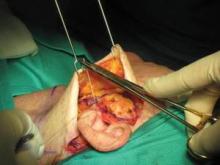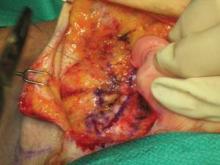User login
ORLANDO - By adopting an abdominoplasty plication technique, a California facial plastic and cosmetic surgeon is pioneering a minimally invasive facelift.
The revision rate among 1,535 patients was less than 1% over an average 1.5-year follow-up, Dr. Kevin Sadati said at the annual meeting of the American Academy of Cosmetic Surgery.
Initial anchoring of the suture at 45 degrees. (Photo courtesy: Dr. Kevin Sadati)
Using a double C-plication technique in the face offers several advantages over the traditional method, he said in an interview. "I use a double-layered interlocking suture, which gives you multiple fixation points and ensures that, over time, the tissue will stay in place and not lead to early tissue laxity," said Dr. Sadati of Newport Beach, Calif.
The technique also provides tissue traction along multiple vectors, he said in an interview. "It creates a more uniform suspension with less bunching compared to traditional plication sutures, which only provide point-specific tension," he said.
Dr. Sadati developed this technique after a number of his early facelift patients came back for revisions due to tissue laxity or bunching. "I decided to change my technique to something that would avoid failure of the plication. In my abdominoplasties, I was using a double-layer plication and, despite great forces exerted in the abdomen, the plication did not fail. I thought perhaps I could apply that same technique to the face," he said.
Using cadaver studies, Dr. Sadati determined that it was possible to adapt the same plication technique used in abdominoplasty to the facial superficial musculoaponeurotic system (SMAS). "I apply the first anchoring suture at the angle of the mandible, followed by double-layer interlocking sutures. In order to create a natural look without the 'pulled look,' I apply gradual tension with various vectors on the SMAS," he explained.
At the superior portions, he only tightens the SMAS 20%-30%. As he goes down toward the mandible, he increases the tension so that at the jaw lines, the SMAS is 100% tightened. "This creates a uniform, natural tension on the SMAS and a smooth look without pulled mouth or tissue bunching by the hairline," Dr. Sadati said.
The procedure lifts the jowls and provides excellent lift to the neck. "It improves any kind of neck, from neck with minimal laxity to the heaviest and the most difficult neck," he said.
He performs the surgery while patients are awake, using 1% lidocaine with epinephrine and tumescent infiltration to the submental and jowl area. Patients also receive oral sedation with diazepam and diphenhydramine. No drain is necessary, and the exterior sutures are absorbable.
He presented data on 1,532 patients he has followed for an average of 1.5 years (maximum 3 years). Of these, 110 had undergone previous facelifts by other surgeons. The postsurgical complication rate was low, with no facial nerve injuries and two greater auricular nerve injuries (some numbness behind ear).
There were 11 revisions (10 women and one man), for a total revision rate of 0.7%. The low revision rate is the best indication of the technique's success.
"The most important result is the high patient satisfaction rate," he noted.
Dr. Sadati had no financial disclosures relevant to his presentation. He teaches the technique but does not receive remuneration for that.
Double layered interlocking plication of the neck is shown. (Photo courtesy: Dr. Kevin Sadati)
ORLANDO - By adopting an abdominoplasty plication technique, a California facial plastic and cosmetic surgeon is pioneering a minimally invasive facelift.
The revision rate among 1,535 patients was less than 1% over an average 1.5-year follow-up, Dr. Kevin Sadati said at the annual meeting of the American Academy of Cosmetic Surgery.
Initial anchoring of the suture at 45 degrees. (Photo courtesy: Dr. Kevin Sadati)
Using a double C-plication technique in the face offers several advantages over the traditional method, he said in an interview. "I use a double-layered interlocking suture, which gives you multiple fixation points and ensures that, over time, the tissue will stay in place and not lead to early tissue laxity," said Dr. Sadati of Newport Beach, Calif.
The technique also provides tissue traction along multiple vectors, he said in an interview. "It creates a more uniform suspension with less bunching compared to traditional plication sutures, which only provide point-specific tension," he said.
Dr. Sadati developed this technique after a number of his early facelift patients came back for revisions due to tissue laxity or bunching. "I decided to change my technique to something that would avoid failure of the plication. In my abdominoplasties, I was using a double-layer plication and, despite great forces exerted in the abdomen, the plication did not fail. I thought perhaps I could apply that same technique to the face," he said.
Using cadaver studies, Dr. Sadati determined that it was possible to adapt the same plication technique used in abdominoplasty to the facial superficial musculoaponeurotic system (SMAS). "I apply the first anchoring suture at the angle of the mandible, followed by double-layer interlocking sutures. In order to create a natural look without the 'pulled look,' I apply gradual tension with various vectors on the SMAS," he explained.
At the superior portions, he only tightens the SMAS 20%-30%. As he goes down toward the mandible, he increases the tension so that at the jaw lines, the SMAS is 100% tightened. "This creates a uniform, natural tension on the SMAS and a smooth look without pulled mouth or tissue bunching by the hairline," Dr. Sadati said.
The procedure lifts the jowls and provides excellent lift to the neck. "It improves any kind of neck, from neck with minimal laxity to the heaviest and the most difficult neck," he said.
He performs the surgery while patients are awake, using 1% lidocaine with epinephrine and tumescent infiltration to the submental and jowl area. Patients also receive oral sedation with diazepam and diphenhydramine. No drain is necessary, and the exterior sutures are absorbable.
He presented data on 1,532 patients he has followed for an average of 1.5 years (maximum 3 years). Of these, 110 had undergone previous facelifts by other surgeons. The postsurgical complication rate was low, with no facial nerve injuries and two greater auricular nerve injuries (some numbness behind ear).
There were 11 revisions (10 women and one man), for a total revision rate of 0.7%. The low revision rate is the best indication of the technique's success.
"The most important result is the high patient satisfaction rate," he noted.
Dr. Sadati had no financial disclosures relevant to his presentation. He teaches the technique but does not receive remuneration for that.
Double layered interlocking plication of the neck is shown. (Photo courtesy: Dr. Kevin Sadati)
ORLANDO - By adopting an abdominoplasty plication technique, a California facial plastic and cosmetic surgeon is pioneering a minimally invasive facelift.
The revision rate among 1,535 patients was less than 1% over an average 1.5-year follow-up, Dr. Kevin Sadati said at the annual meeting of the American Academy of Cosmetic Surgery.
Initial anchoring of the suture at 45 degrees. (Photo courtesy: Dr. Kevin Sadati)
Using a double C-plication technique in the face offers several advantages over the traditional method, he said in an interview. "I use a double-layered interlocking suture, which gives you multiple fixation points and ensures that, over time, the tissue will stay in place and not lead to early tissue laxity," said Dr. Sadati of Newport Beach, Calif.
The technique also provides tissue traction along multiple vectors, he said in an interview. "It creates a more uniform suspension with less bunching compared to traditional plication sutures, which only provide point-specific tension," he said.
Dr. Sadati developed this technique after a number of his early facelift patients came back for revisions due to tissue laxity or bunching. "I decided to change my technique to something that would avoid failure of the plication. In my abdominoplasties, I was using a double-layer plication and, despite great forces exerted in the abdomen, the plication did not fail. I thought perhaps I could apply that same technique to the face," he said.
Using cadaver studies, Dr. Sadati determined that it was possible to adapt the same plication technique used in abdominoplasty to the facial superficial musculoaponeurotic system (SMAS). "I apply the first anchoring suture at the angle of the mandible, followed by double-layer interlocking sutures. In order to create a natural look without the 'pulled look,' I apply gradual tension with various vectors on the SMAS," he explained.
At the superior portions, he only tightens the SMAS 20%-30%. As he goes down toward the mandible, he increases the tension so that at the jaw lines, the SMAS is 100% tightened. "This creates a uniform, natural tension on the SMAS and a smooth look without pulled mouth or tissue bunching by the hairline," Dr. Sadati said.
The procedure lifts the jowls and provides excellent lift to the neck. "It improves any kind of neck, from neck with minimal laxity to the heaviest and the most difficult neck," he said.
He performs the surgery while patients are awake, using 1% lidocaine with epinephrine and tumescent infiltration to the submental and jowl area. Patients also receive oral sedation with diazepam and diphenhydramine. No drain is necessary, and the exterior sutures are absorbable.
He presented data on 1,532 patients he has followed for an average of 1.5 years (maximum 3 years). Of these, 110 had undergone previous facelifts by other surgeons. The postsurgical complication rate was low, with no facial nerve injuries and two greater auricular nerve injuries (some numbness behind ear).
There were 11 revisions (10 women and one man), for a total revision rate of 0.7%. The low revision rate is the best indication of the technique's success.
"The most important result is the high patient satisfaction rate," he noted.
Dr. Sadati had no financial disclosures relevant to his presentation. He teaches the technique but does not receive remuneration for that.
Double layered interlocking plication of the neck is shown. (Photo courtesy: Dr. Kevin Sadati)

